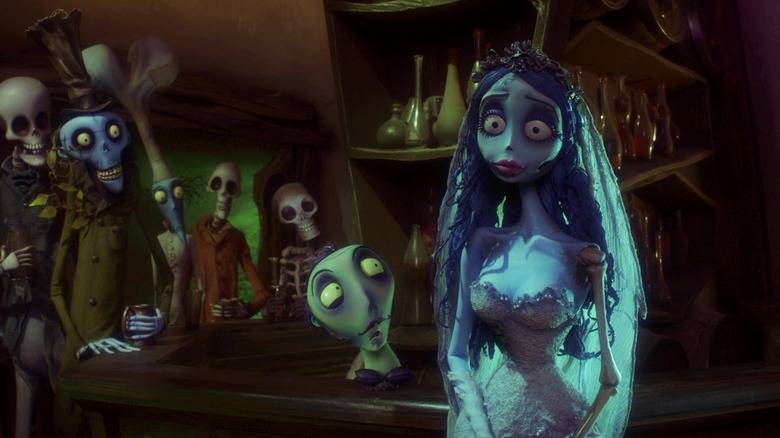Guillermo Del Toro's Frankenstein Is The Perfect Companion To The Most Underrated Tim Burton Movie
Guillermo del Toro's new film adaptation of "Frankenstein" takes a similar approach to the Monster as Kenneth Branagh did in his 1994 film "Mary Shelley's Frankenstein." In both films, Dr. Frankenstein (Oscar Isaac in del Toro's film, Branagh in Branagh's) is presented as an ambitious agent of chaos, a thoughtless character who doesn't consider the moral ramifications of reanimating a stitched-together corpse. Isaac's Frankenstein, however, is presented as heartless and abusive, while Branagh is more zestily oblivious. Both of them, however, are filmed with swirling camera movements and fast editing. Frankenstein is a creature of dizzying movement.
The Monster, in contrast, is a gentle creature, a child without experience. In both the 1994 and the 2025 films, the camera stops moving when it looks at the monster. There is no music underneath it. The Monster walks through the woods, communing with animals and staring longingly (from a distance) into the home of a happy, warm, woods-dwelling family. Frankenstein is dizzying and violent. The Monster itself learns that there is gentleness in the world.
Del Toro, however, cast the tall and handsome Jacob Elordi as his Monster. Despite his scarred face and stitched-up body, del Toro's Monster is a magazine-ready pretty-boy. He is not full of hidden rage, but an approachably poetic, college-level goth angst. This Monster has long, dark locks barely hiding his deep, soulful eyes. He quotes Percy Shelley and reads John Milton. He is, in presentation, a sullen outsider who longs for love; the type of Monster that will inspire many young women to whisper quietly to themselves, "I can fix him."
And when it comes to sullen, poetic ... and dead ... outsiders who openly long for love, the Monster has a soul sister in Emily (Helena Bonham Carter), the title character from Tim Burton's "Corpse Bride."
Frankenstein is a spiritual cousin to Corpse Bride
"Corpse Bride," recall, was Burton's stop-motion animated film from 2005 that starred Carter, Johnny Depp, and Emily Watson. The story followed a shy young man named Victor who was betrothed to the equally shy Victoria, only marrying to merge their respective family fortunes. Victor and Victoria find that they get along, but Victor is too nervous to enact the complex wedding ceremony. Fleeing into the woods, Victor jokingly practices the ceremony by placing his wedding ring on a nearby tree branch.
The branch, however, is actually the half-buried skeletal hand of Emily, a woman who was killed in the woods many months before. The ring brings her back to life, and she, decomposing, instantly falls in love with her new groom. She spirits him away, and they spend an extended period in the Afterlife, meeting jolly corpses and smiling, singing skeletons. Victor can play nice, but longs to flee his new corpse bride and return to the land of the living.
Emily, like many of Tim Burton's protagonists (think also of Edward Scissorhands or Jack Skellington) only needs love in her life. She is full of melancholy, but joy erupts quietly within her when another human being looks at her with affection. Also like Burton's other protagonists, she is somewhat outwardly monstrous. Emily is dead, after all. She needs love, but scares people. She will not be able to rest until her heart can be filled.
And Emily is full of light and poetry. She can play the piano and loves dancing and music. At the end of the film, when Emily's soul is finally released, she explodes into a flutter of butterflies. She has beauty in her spirit. It's a pity Emily could never become the Bride of Frankenstein.
My little Frankenstein has the sweetest smile
Del Toro's Monster, comparatively, is a repellent but lovelorn character. He is a perfectly pretty goth sadboy. Were he not a beastly, wilderness-dwelling corpse, this Monster would be seen at Florence and the Machine concerts, drinking exotic coffees, and browsing at Powell's bookstore in Portland. Back in 1818, the Monster was created by Mary Shelley, but del Toro pictures him as the type of dude that would shout Percy Shelley quotes from your front lawn. How fittingly ironic that the Monster knows "Ozymandias" and the egocentric Victor Frankenstein doesn't. If it wasn't clear that this Monster wasn't meant to be seen as a romantic sufferer, del Toro ends his film with an on-screen quote from Lord Byron.
Indeed, del Toro seems to be repeating Tim Burton's shtick. Burton is a master of outsiders, people who are pleased to live outside of the mainstream, but who often long for a way in. Not because they need to be popular or accepted, but because they can find love and company in there. Batman, Edward Scissorhands, Ed Wood, Jack Skellington, and, of course, Emily ... these are all elder members of del Toro's Monster's family.
Del Toro's film is far from perfect. The first half is sloppy and overstuffed, the monster action is silly, and the Mia Goth character is tremendously shallow and one-dimensional. But the gore is terrific, and, importantly, the Monster is immensely appealing. He is your Corpse Groom. He is the dead man with the beating heart. Although capable of murdering people by the score, this Monster just wants to read books, pick flowers, and have a companion, a Bride of his own.
He and Tim Burton's Emily would have gotten along swimmingly.


